The VertiGIS FM Maintenance search page provides an overview of all assets within the maintenance hierarchy in the system and allows you to search and filter using various maintenance data as criteria.
You can also create new instances of certain data objects managed in a given VertiGIS FM product or module on its search page.
You can access the VertiGIS FM Maintenance search page by expanding Maintenance in the left pane and clicking Search.
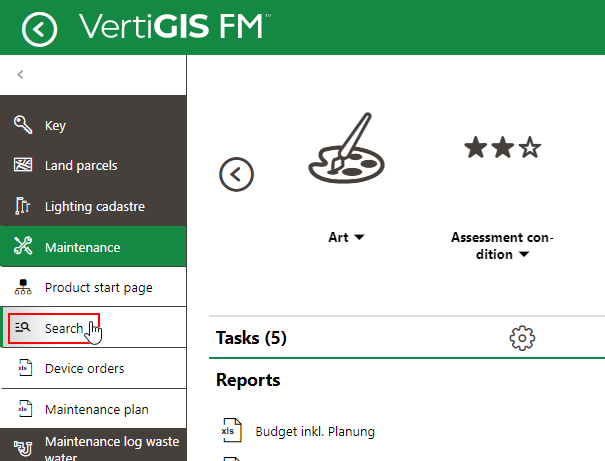
Link to VertiGIS FM Maintenance Search Page
Objects
In the Objects section, you can click an asset or maintenance task associated with VertiGIS FM Maintenance to view a list of the selected object type in the system. If you click Components, for example, the search grid shows all the components that have been created in the system as well as key data points in the table columns.
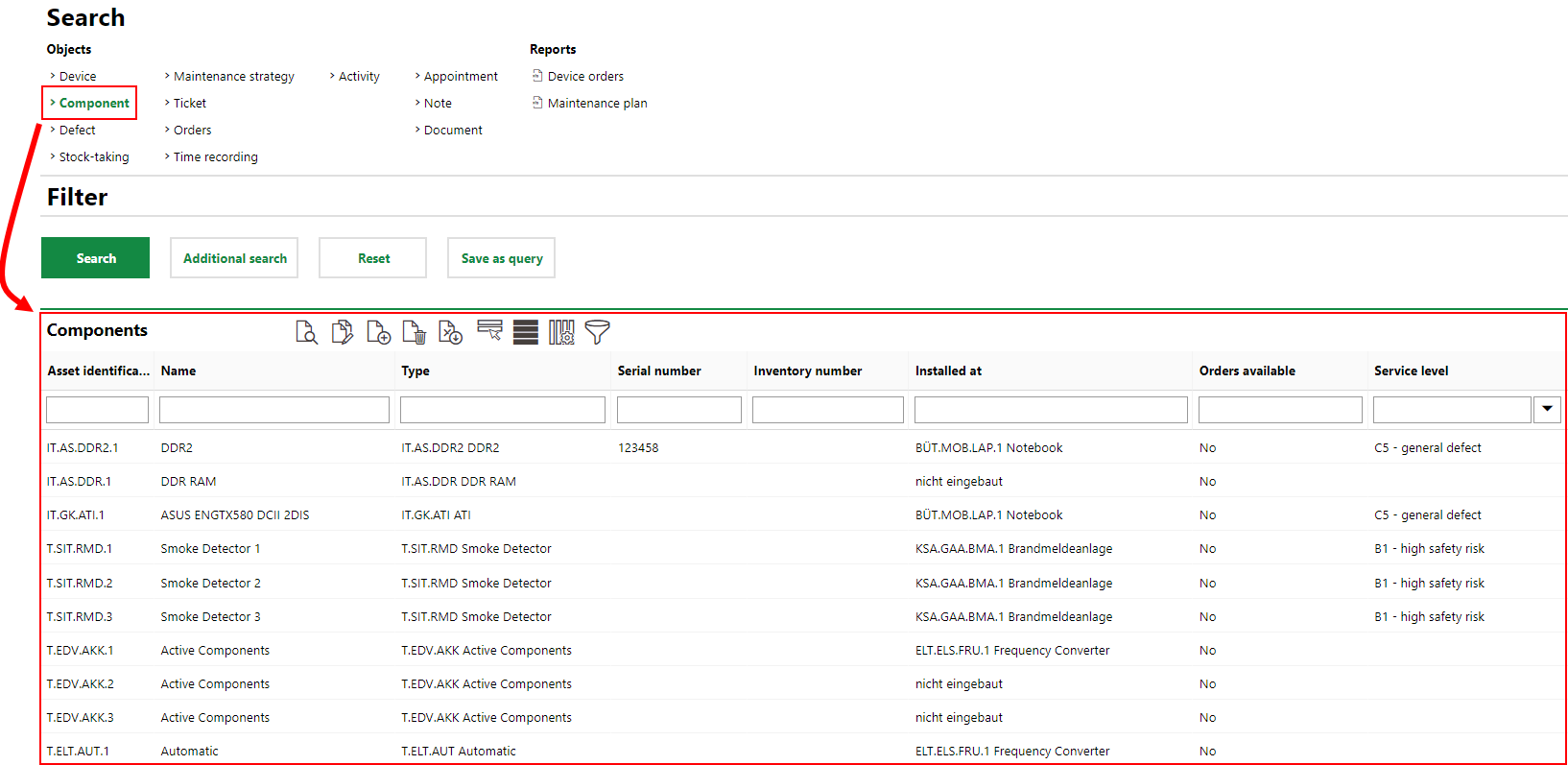
Components Shown on VertiGIS FM Maintenance Search Page
In addition to components, you can use the search page to query the system for devices, defects, maintenance strategies, service desk tickets, orders, invoices associated with maintenance assets, time recordings, appointments, notes, and documents.
Devices
You can identify devices in the search grid by the statuses below.
Device Statuses
Status |
Display on Search Page |
Description |
|---|---|---|
Active |
Black |
The device is in operation. |
Not Active |
Red |
The device is not in operation. It cannot have orders created or generated for it. |
Stored |
Red |
The device is not in operation but can still have orders created and generated for it. |
In Rejection |
Red |
The device appears in search lists but cannot have orders created or generated for it. |
Rejection |
Hidden (red when Include History is selected) |
The has been permanently retired. You must select the Include History check box on the search page to see the the device in search lists. |
Orders
You can identify the status of orders in the search grid by the icons and statuses below.
Order Statuses
Status |
Description |
|---|---|
Planned |
No work associated with the order has begun. |
In progress |
Work associated with the order is underway. VertiGIS FM updates an order to this state when work orders or subcontracts are added to it. |
Finished |
All items associated with the order have been completed. An order cannot be marked as Finished if any checklist tasks, work orders, or subcontracts on the order details page have not themselves been marked as completed. When you mark the last outstanding checklist task, work order, or subcontraction is marked complete, the order's status programmatically updates to Finished. The search page only shows these orders if you select the Include History check box in the Filter menu. |
The icon symbol that accompanies the order in search pages and on details pages is based on its deadlines and not necessarily its status.
Order Status Symbols
Symbol |
Description |
|---|---|
|
The intended deadline is in the future. |
|
The intended deadline has passed, and the order is overdue. |
|
The present time is between the lead time and the intended time, or the present time is between the intended time and the follow-up time. |
|
The order is complete. |
|
The order was closed, but the work associated with the order was not completed. Refer to Not Carried Out. |
When any object is selected, you can click the Show/Hide Columns (![]() ) icon to add or remove data points from the search grid.
) icon to add or remove data points from the search grid.
Search List Authorization
If the data object whose instances you want to see in the search grid does not appear in the Objects section, you may need to edit the search list authorization to show it.
Only user assigned user roles with administrative privileges can complete this action.
To edit the search list authorization, click the gear icon in the top-right corner of the search page.

Edit Search List Authorization
You can then show hidden search objects by selecting the radio button in the Visible column, or hide it by selecting the radio button in the Invisible column.

Search List Authorization
Click Save and Close to activate any changes you make to the search list authorization.
Section authorization is dictated on a user role basis. Ensure you have selected the role for which you want to show or hide a section before completing the steps below.
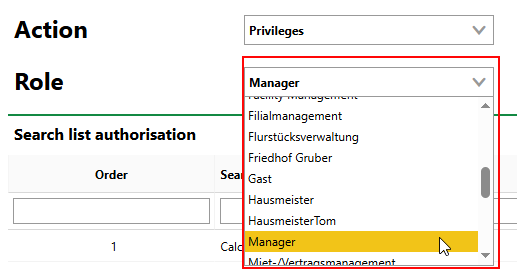
Role Selection for Search List Authorization
Filter
You can expand the Filter tab to narrow a search based on additional Master Data criteria used in VertiGIS FM Maintenance. To view the additional criteria available, click Filter.
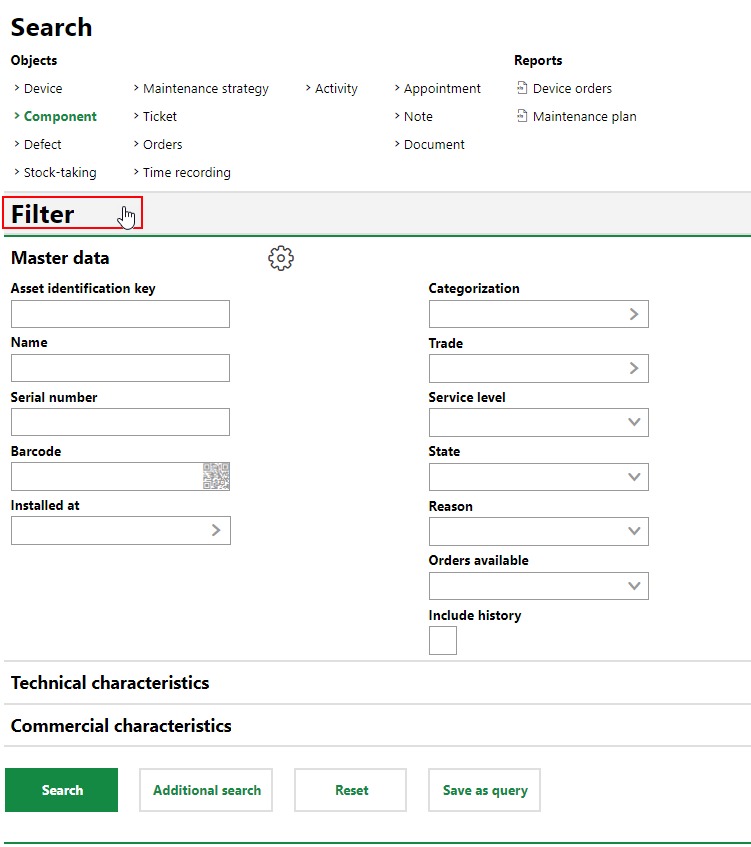
Expanded Filter Section on VertiGIS FM Search Page
The master data that can be used to search will vary based on the VertiGIS FM product you're using and the item you've clicked in the Objects section.
Click the Reset button to remove all inputs from the search fields in the Filter section.

Reset Button the Search Page
You can save queries, which are lists of the object selected in the Objects section filtered using the search criteria entered in the Filter section, so that other users can generate PDFs based on them. Refer to Save Queries for more information.
Include History
To find data objects whose statuses indicate they are permanently retired (for example, a device whose status is Rejected), you must select the Include History check box to see the data object in the search grid.

Include History Check Box
Filter by Date
Data objects whose operation or validity is associated with a date property, like End of Service or Commissioning, can be filtered using the date associated with the corresponding filter when the object type is selected under Objects on the search page for the product in which it is managed.
For example, in VertiGIS FM Buildings, if you search the database for real estates set to expire between August 28 and 30, the results only include real estates whose End of Service date is between the two search dates.
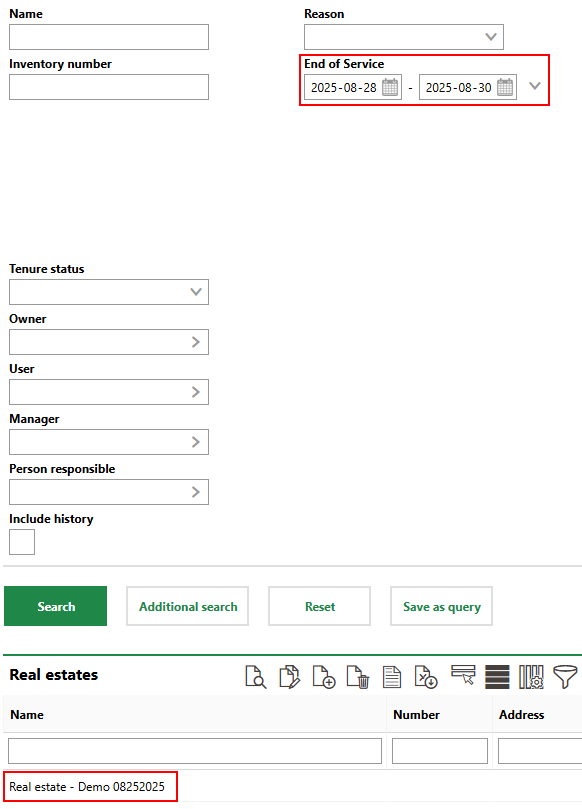
End of Service Filter Using Dates
The End of Service date on the real estate that appears in the search results in the example above is August 29, 2025.

End of Service Property in Real Estate Details
Period of Time from Current Date
As an alternative to searching for objects using specific End of Service dates as a filter, you can filter using any number of days, weeks, months, or years before or after the current date as search criteria. To conduct this kind of search using a data object's End of Service end date, click the down-arrow button next to the right of the date boxes.
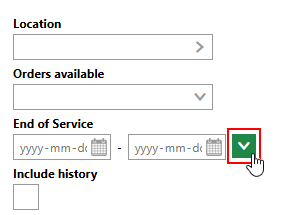
End of Service Drop-Down
Use the rules below to search for data objects whose End of Service date is within a certain range of time from the current date:
•Leave the boxes for the End of Service start and end dates blank (i.e., no dates selected).
•From the menu in the leftmost-box, select an operator. Refer to Date Operators.
•In the middle text box, enter a number.
•From the menu ion the rightmost box, select Days, Weeks, Months, or Years.
Operator |
Description |
|---|---|
< |
Only objects whose date property is before the current date and within the amount of time specified in the filter are listed. For example, this operator with "3 weeks" would include results whose property for the specified date field is within the last 3 weeks. |
<= |
Only objects whose date property is before the current date and within or equal to the amount of time specified in the filter are listed. For example, this operator with "3 weeks" would include results whose property for the specified date field is within the last 3 weeks. |
<< |
Only objects whose date property is before the current date by more than the amount of time specified in the filter are listed. For example, this operator with "3 weeks" would include results whose property for the specified date field is more than 3 weeks ago. |
>= |
Only objects whose date property is after the current date and within or equal to the amount of time specified in the filter are listed. For example, this operator with "3 weeks" would include results whose property for the specified date field is within the next 3 weeks. |
> |
Only objects whose date property is after the current date and within the amount of time specified in the filter are listed. For example, this operator with "3 weeks" would include results whose property for the specified date field is within the next 3 weeks. |
>> |
Only objects whose date property is before the after date by more than the amount of time specified in the filter are listed. For example, this operator with "3 weeks" would include results whose property for the specified date field is more than 3 weeks into the future. |
If you are searching for objects using a date property and an amount of time in the past (i.e., using the <, <=, or << operators), you must ensure the State filter matches the status of objects whose date property is in the past (for example, Rejected for a building whose End of Service date has passed), and that the Include History check box is selected. Refer to Include History.
These inputs combine to search for instances of the selected data object whose End of Service date is within a certain amount of time from the current date. In the example below, the system searches the database for devices whose End of Service is 3 months in the future from the current date (August 25, 2025).
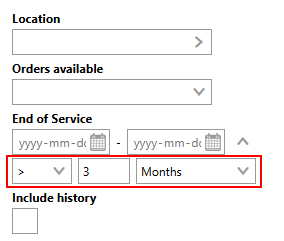
End of Service Search from Current Date
In this example, the search yields a single device.
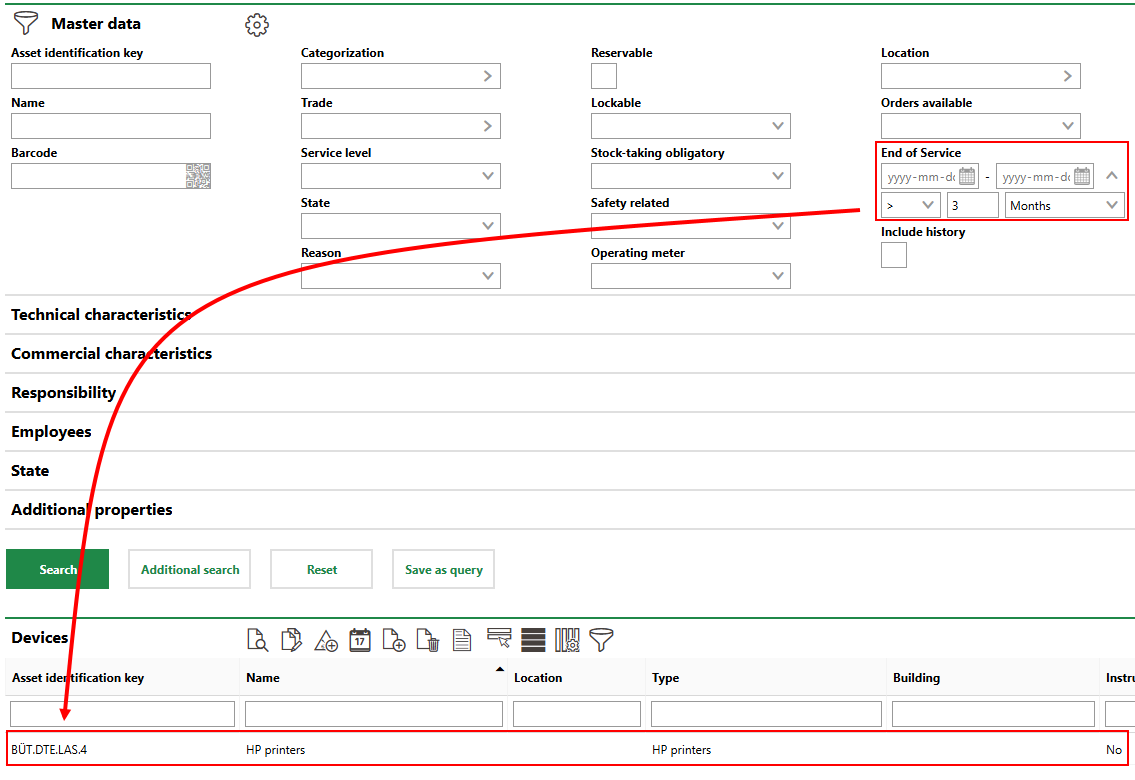
Search for Devices Whose End of Service Date is 3 Months from Current Date
The device's End of Service date is November 1, 2025, which is within 3 months of the date the search shown above is being executed (August 25, 2025).
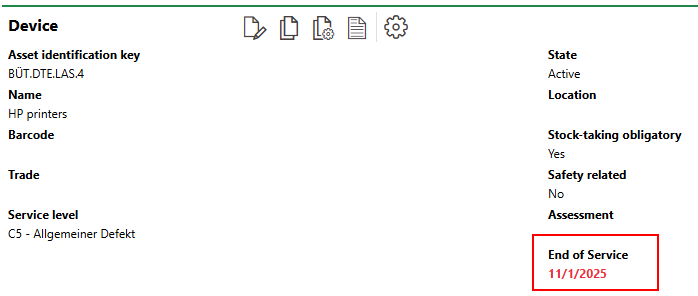
Device End of Service Date
The name of the field that describes an object or asset's end of use varies by VertiGIS FM product. The functionality outlined above applies to all filters associated with date properties.
Search Tool Icons
The panel on the top of the search grid contains a row of icons with tools that can be used to apply an action directly to the selected item in the search table or to the search results in general.

Search Tool Icons
The available icons vary depending on the object selected. In VertiGIS FM Maintenance, for example, you can create a new device, component, defect, ticket, or order on the search page when you select one of those objects in the Objects section and then click the Add (![]() ) icon. When you select Appointment, the Add (
) icon. When you select Appointment, the Add (![]() ) icon is not available; appointments must be created on the details page for the object with which they are associated (for example, the device). All VertiGIS FM products have data objects that cannot be created on the search page.
) icon is not available; appointments must be created on the details page for the object with which they are associated (for example, the device). All VertiGIS FM products have data objects that cannot be created on the search page.
Search Grid Tool Icons
Icon |
Description |
|---|---|
|
Opens the details page for the item selected in the search grid. Equivalent of double-clicking an item in the search grid. |
|
Opens a dialog showing the location of the selected item on a map. |
|
Allows you to batch edit all the selected items in the search grid. |
|
In VertiGIS FM Maintenance, opens a form to generate collective works orders or subcontractions for the individual orders selected in the search grid. |
|
In VertiGIS FM Maintenance, opens a form to manually create a new order order for all selected items in the search grid. |
|
Opens the form to add a new item for the object type shown in the search grid. |
|
Deletes the selected item. |
|
Open a list of reports you can download using data from the rows selected in the search grid. Report definitions must be uploaded for the data source whose data object is selected under Objects. This icon has additional features in some workflows. For example, clicking it when an Invoices are selected under Objects allows you to print the invoice, which processes it. |
|
Exports the selected rows into an Excel spreadsheet. |
|
Removes all unselected items from the search grid. |
|
Selects all the items in the search grid. |
|
Opens a dialog that allows you to show or hide columns. |
|
Shows or hides the search boxes under each column header that are used to filter the search results. |
The availability of the icons shown in the table above varies depending on the VertiGIS FM product and the object selected in the Objects section.
Show or Hide Columns
When you click the Show/Hide Columns (![]() ) icon, you can select which of the data points (or properties) associated with the data object selected under Objects you want to see as columns in the search grid.
) icon, you can select which of the data points (or properties) associated with the data object selected under Objects you want to see as columns in the search grid.
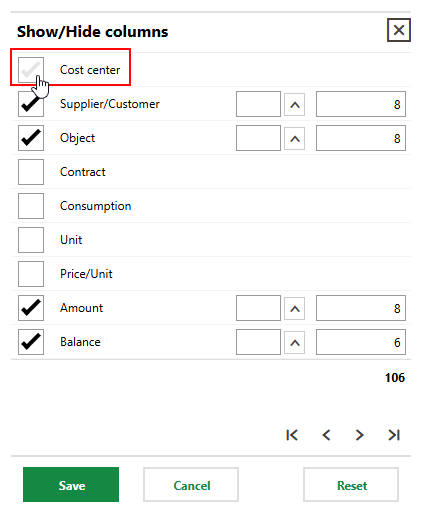
Selecting Data Point
Selected data points have sortable columns when the data object is selected in the grid. Deselected data points are hidden.
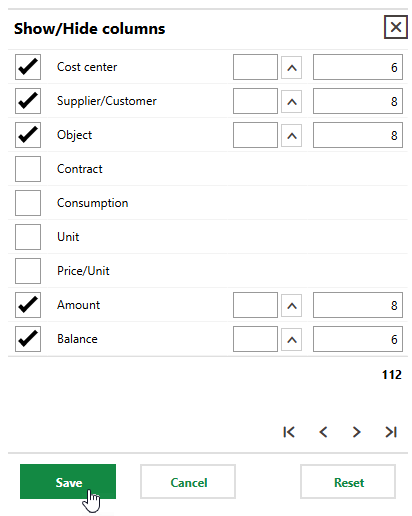
Saving Show/Hide Columns
After you click Save, the data point appears in the search grid. You can sort or filter the selected data object using the property.
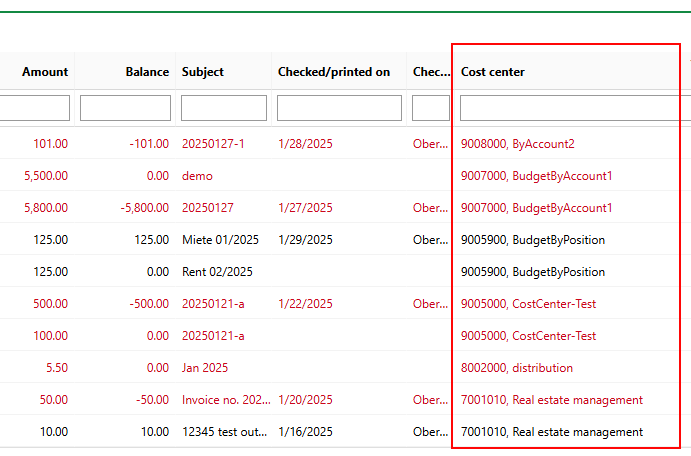
Column Added to Search Grid
Additional Search
The Additional Search feature allows you to search the selected item in the Objects section for more than one criteria in the same field. For example, in VertiGIS FM Buildings, you could use it to search for a list of tables and chairs that are located in one specific room. Similar examples could apply to other VertiGIS FM products.
To Perform an Additional Search
1.On the search page, expand the Filter tab.
2.Enter or select a value in one of the search fields.
3.Click Additional Search. The first search criteria is now listed under Search Criteria.
4.Enter or select another value in one of the search field. In the primary use case for the Additional Search feature, you are entering or selecting a different value for the same field as the first search criteria.
5.Click Additional Search.
6.Repeat steps 2 and 3 until you have all the criteria you want is shown under Search Criteria..
7.Click Search.
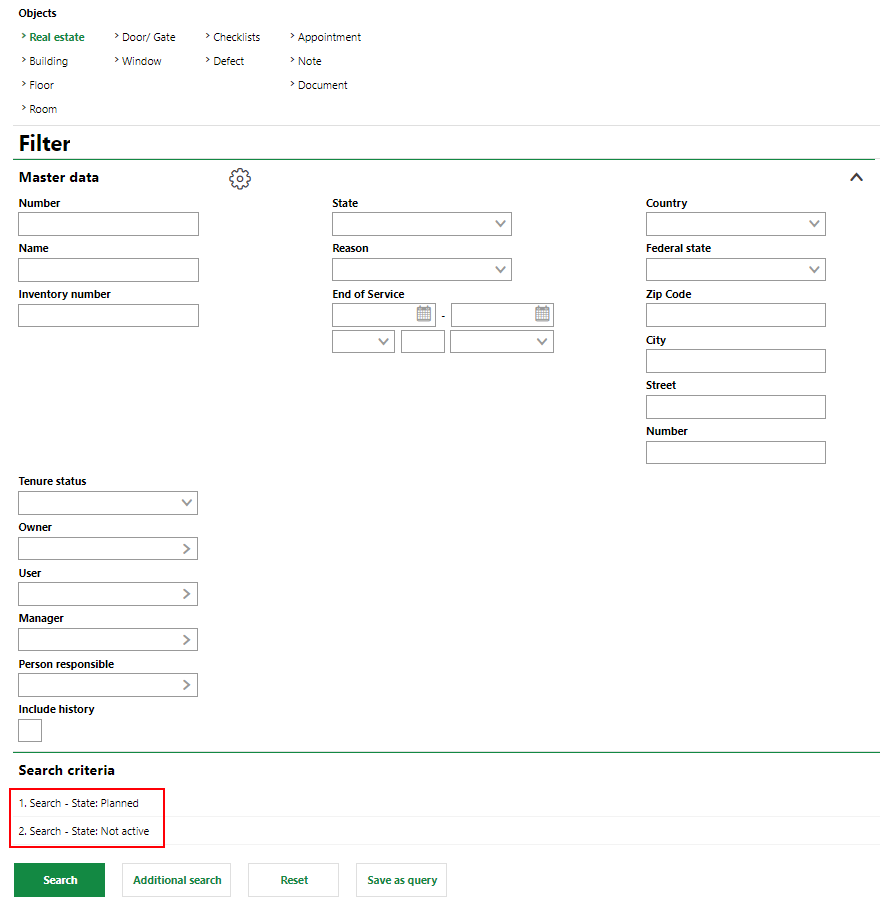
Additional Search Criteria for Real Estates with a Status of Planned or Not Active



